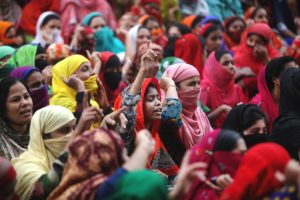Worker-Driven Social Responsibility
 What is WSR (vs. CSR)?
What is WSR (vs. CSR)?
For decades, corporations have responded to the severe human and labor rights abuses endemic to their supply chains by launching “corporate social responsibility” programs. Yet the abuses have persisted, leaving millions working in abusive conditions for poverty wages. The WRC and our allies are advancing a new, more effective labor rights governance model in supply chains: a Worker-driven Social Responsibility model.
“Corporate social responsibility” (CSR) programs create standards without enforcement. They often center on corporate “codes of conduct” that purport to protect the rights of supply chain workers, but these codes are never meaningfully enforced. CSR programs do not impose binding obligations on companies, meaning that there are no consequences when they violate their own codes. They also fail to provide a role for workers, giving them no voice or power to protect their own rights. And they fail to place economic responsibility for improved wages and working conditions at the top of the supply chain. Unsurprisingly, these programs have failed to change conditions for workers—and have instead served as public relations programs for brands by giving the appearance that they are taking action.
The Worker-driven Social Responsibility (WSR) model, by contrast, has a track record of effectiveness across a range of industries, including the garment industry. It centers on the use of legally-binding agreements between workers and companies at the top of supply chains that require those companies to ensure their suppliers respect workers’ rights—and stop doing business with those that do not. In doing so, WSR provides a new form of power for workers to protect and enforce their own rights, including the right to freedom of association, the right to a safe work environment, the right to work free from sexual harassment and sexual violence, and the right to work free of forced labor. Under WSR programs, it is workers who determine the labor standards under which they work and who design the systems necessary to enforce those standards, including genuinely independent investigations and mechanisms to resolve complaints. And the WSR model requires companies at the top of supply chains to pay to help change working conditions.
The Accord on Fire and Building Safety in Bangladesh is a leading example of how the WSR model can transform working conditions. Before the Accord, virtually no garment factory in Bangladesh operated safely. Almost none of them had a safe fire exit, and many had numerous other hazards, such as unsafe electrical wiring and dysfunctional fire alarms. The Accord, signed in the wake of the Rana Plaza building collapse that killed 1,137 workers, has ushered in vastly safer working conditions for more than two million workers. Under the Accord, over 150,000 safety renovations have been carried out across more than 1,600 factories. The Accord achieved this success through the signing of a binding agreement between 200 major apparel companies and unions that contractually commits the companies to ensuring their supplier factories are made safe. Brand signatories must allow independent inspectors to investigate their factories, and must ensure safety hazards are repaired. Signatory companies are required to terminate their business with any supplier that refuses to make their factories safe.
The WRC is a technical advisor to the Worker-driven Social Responsibility Network (WSR-N), which works to replicate and promote the WSR model and discredit the failed CSR model.
Read more about Worker-driven Social Responsibility on the WSR-N website.
